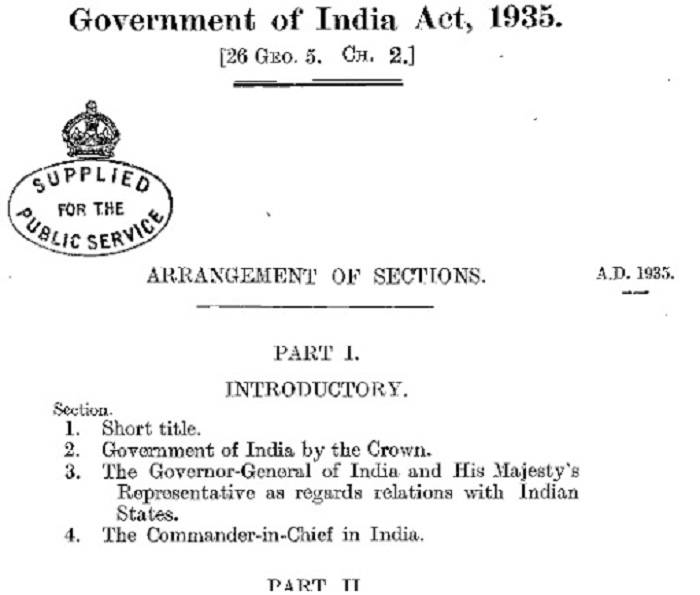The third round table conference was held in November 1932, without the participation of Congress. These discussions led to the formation of the Government of India Act 1935. With the appointment of the Simon Commission in November 1927, the procedure of enactment of the Government of India Act 1935 commenced.
The Simon Commission visited India twice, its report was discussed at the Round Table conference, after the end of the Round Table conference, and a white paper was introduced in the British parliament. A joint community of both the houses of parliament was formed chairmanship of Lord Linlithgo. The report of the joint community prepared the basis for the enactment act of 1935.
We will discuss the following in this post related to the Government of India Act 1935:
Main Features of Government of India Act 1935

The Government of India Act was passed in August 1935 provided provincial autonomy to states. This also helped in the diarchy introduction at the central government. This also provided for the establishment of federal court. The instrument of instruction which contained direction to the Viceroy (Governor-General) & Governor to use their authority in the larger interest of the people.
This Government of India Act 1935 divided the subjugated of admin intro three list – Central, provincial, and concurrent list. This explained the interrelation between the executive & legislative power of the center & state.
Indian’s Reaction to the Government of India Act 1935
The provision of Act 1935, was nowhere close to India’s aspiration because congress demanding complete independence at that time but there was no trace of independence in the provision of this act. The concept of provincial autonomy was forced because real powers were still in British hands. The Viceroy (Governor-General) & Governor enjoyed veto powers.
Congress strongly opposed the introduction of diarchy at the center because it failed at the provincial level. Congress wanted all native states must compulsorily join the Indian federation but the act gave freedom to native sate to decide where they wanted to be part of the federation or not. Congress wanted people should elect a representative of the native state in the proposed federation but the act proposed their nomination by the native ruler. Congress was against the system of a separate electorate. Here are the complete provisions of the Government of India Act of 1935:
An All India Federation
This act comprises all British Indian provinces, all chief commissioner’s provinces, and the Indian States. The Federation formation was conditional on the fulfillment of two conditions; states with the allotment of 52 seats in the proposed Council of the states must agree to join the federation and second was the aggregate population of states in the above population of all Indian States.
Federal Level divisions (Executive and Legislature)
Executive: Governor-General was the center of the entire Constitution. The subjects to be governed were divided into two lists, first is reserved and second is transferred subjects. Reserved subjects were foreign affairs of British India, tribal areas, and ecclesiastical affairs. Reserved subjects were to be administered by Governor-General on the advice of executive councilors. Executive Councillors were not supposed to be responsible for the Central legislature. The Non-executive list which was also termed as transferred subjects included all other non-executive subjects and were to be governed by the Governor-General on the recommendation of ministers elected by the legislature.
Legislature: The nature of legislature was bicameral which constitutes of Upper House (Council of States) and a lower house (Federal Assembly). The upper house was a 260-member house, in which councils were to be partly elected from British Indian provinces and about 40 percent were to be nominated by princes. The lower house constitutes a 375-member house.
Provincial Autonomy
This was the most important reforms in this act. This act replaces diarchy being introduced in the Montagu-Chelmsford reforms of 1919. It provides separate legal identity to the states and granted autonomy. The superintendence direction from the secretary of the states and governor-general was no longer imposed on the States. The financial power of independence was also granted for the states.
Significance of Government of India Act 1935
Act of 1935 carried the procedure of constitutional advancement in India till the point to return because once diarchy was introduced to the center, the next logical step was the grant of autonomy to India. This indicated that the attainment of Dominion status was not far away. This act retained the preamble of act 1919, in which it was repeatedly exposed. The constitution advancement of India was an integral part of the British Empire. But in light of the provision of the act, it was nothing more than of the Cheshire category.
Act of 1935 was nothing less than a complete constitution scheme, it contained a provision to bureaucracy executive-legislative & join both center & state. It defined the relation between Calcutta & the provincial government. It was based on the idea of the federation. This provision was about public service communication. This act also provides provision emergency in the fundamental constitution scheme. The instrument of instruction was a chapter of great significance. It was adopted as DBP as Indian Constitution.
The Office of Governor was explained elaborately. This provision of 1935 made the task of drafting an Indian Constitution much easier because 75 percent of parts of the Indian Constitution came from the Government of India Act of 1935

